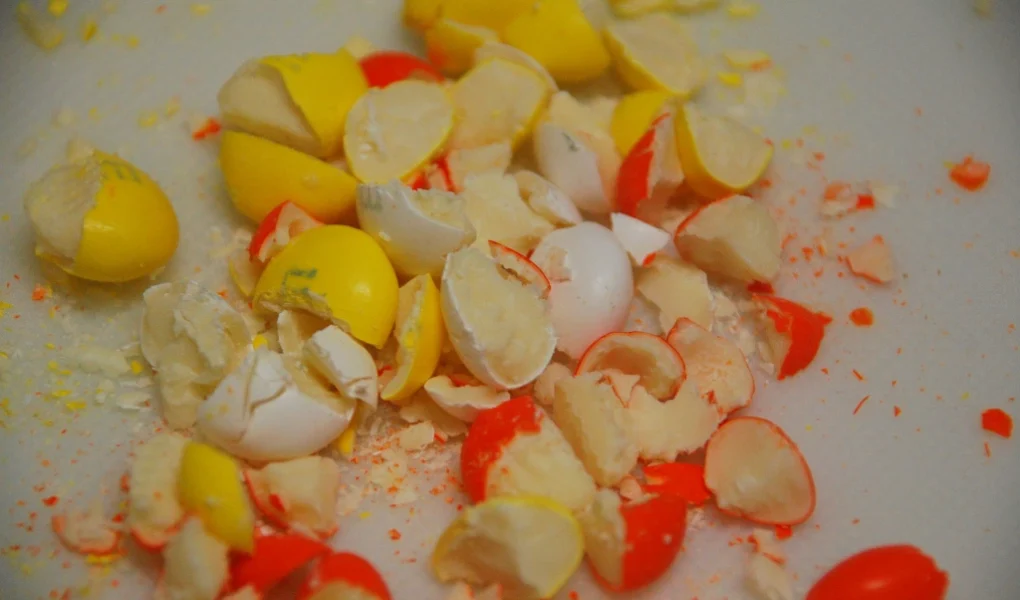Before moving on the topic tapeworm yellow pods in stool first lets talk about what Yellow pods in the stool may indicate the presence of tapeworms. These segmented parasites can release yellowish egg pods in feces, a common sign of an infestation. These pods, frequently appearing small grains, contain tapeworm eggs and are expelled from the body as part of the parasite’s lifecycle. However, it’s pivotal to consult a healthcare professional for proper opinion and treatment, If you notice similar abnormalities. Understanding the significance of these yellow pods can lead to timely intervention, icing better health issues. Identifying tapeworm yellow pods in stool is pivotal for prompt opinion and applicable medical intervention.
What might be the origin of these yellow chunks of poop?
Yellow chunks in poop could appear from colorful causes. One common factor is the presence of undigested fats, which may affect from issues like mal-absorption or a diet high in fat content. Also, certain infections, like giardiasis or a parasitic infestation similar as tapeworms, can contribute to this abrasion. Liver or gallbladder diseases might also impact stool color. While salutary factors play a part, patient yellow chunks warrant medical attention to identify and address any beginning health issues, icing applicable operation and enhancement in digestive well- being.
Causes of Yellow Chunks in Poop
Yellow chunks in poop may stem from colorful causes. Dietary factors, similar as consuming high- fat foods, can lead to undigested fat appearing in stools. Mal-absorption issues, like celiac complaint or pancreatitis, may affect in the inadequate breakdown of fats, contributing to chunky, yellow stool. Infections like giardiasis can affect the digestive system, altering stool color and thickness. Parasitic infestations, specially tapeworms, may manifest as yellowish parts in feces. Liver or gallbladder diseases can impact corrosiveness product and inflow, impacting stool appearance. Patient yellow chunks warrant medical evaluation to pinpoint the beginning issue and companion applicable treatment.
Treatment
Treatment for yellow chunks in poop depends on the underpinning cause. Dietary adaptations, similar as reducing fat input, can address issues related to food digestion. In cases of infections or parasitic infestations, specified by a healthcare professional may be necessary. Operation of mal-absorption conditions involves addressing the root cause, similar as treating celiac complaint or pancreatitis. Liver or gallbladder diseases may bear medical interventions or life changes. Observing tapeworm yellow pods in stool underscores the significance of covering digestive health for timely treatment.
Also Read: What Does Diabetic Poop Smell like?
Preventions
Precluding yellow chunks in poop involves maintaining a balanced diet with acceptable fiber and limiting high- fat foods. Rehearsing good hygiene, especially hand washing, helps reduce the threat of infections. Icing food safety by consuming duly cooked and prepared refection’s can help certain gastrointestinal issues. Regular medical check- ups aid in the early discovery and operation of underpinning health conditions that may contribute to stool abnormalities. Hydration is essential for overall digestive health. However, taking preventives can minimize the threat, If you’re traveling to areas with implicit waterborne infections. Overall, a healthy life and mindfulness of implicit threat factors contribute to prevention.
Can parasite eggs be seen in stool?
Yes, parasite eggs can be visible in stool. When a person is infected with intestinal parasites like worms, their eggs are frequently excreted in the feces. These eggs can vary in size and appearance, ranging from bitsy to visible to the naked eye. Laboratory tests, similar as a stool examination, are generally used to identify and confirm the presence of parasite eggs.
Do stools have white or yellow balls?
Stools with white or yellow balls could indicate colorful health issues. White or pale- multicolored balls may suggest a lack of corrosiveness, potentially linked to liver or gallbladder problems. Yellowish balls might be related to undigested fats, indicating mal-absorption or dietary factors. In certain cases, these could be associated with specific infections or parasitic infestations.
Also Read: Why Does My Poop Smell Like Metal?
What are candida yellow balls in stools?
Candida overgrowth in the digestive system may affect in yellowish balls in the stools. Candida, a type of incentive, can form clumps that are expelled in feces. This may be accompanied by other symptoms, like digestive discomfort or fungal infections. An overgrowth of Candida is frequently linked to factors like a weakened vulnerable system, antibiotic use, or an imbalance in the gut foliage.
What’s the difference between yellow poop and yellow chunks?
Yellow poop generally refers to the overall color of the stool, which can be told by factors like diet, specifics, or underpinning health conditions affecting corrosiveness product. On the other hand, yellow chunks in poop specifically relate to visible, solid pieces within the stool. These chunks may indicate undigested fats, parasites, or other gastrointestinal issues. While yellow poop may be a broader observation, yellow chunks suggest a more detailed consideration of the stool’s composition, frequently warranting medical attention for farther evaluation and opinion.
Conclusion
Detecting tapeworm yellow pods in stool requires attention to detail and a visionary approach to managing implicit parasitic infections. In conclusion, observing yellow chunks in poop signals implicit digestive issues, ranging from dietary factors to underpinning health conditions like infections or parasites. While yellow poop may have colorful causes, the presence of distinct chunks clearances attention. Seeking medical advice is pivotal for an accurate opinion and applicable treatment. Understanding the underpinning factors contributing to the abrasion and texture can guide interventions, icing optimal digestive health. Regular check- ups, a balanced diet, and mindfulness of individual health factors contribute to overall well- being and the prevention of similar stool abnormalities.
Also Read: Yellow Balls in Stool- Main Causes & things to do?



